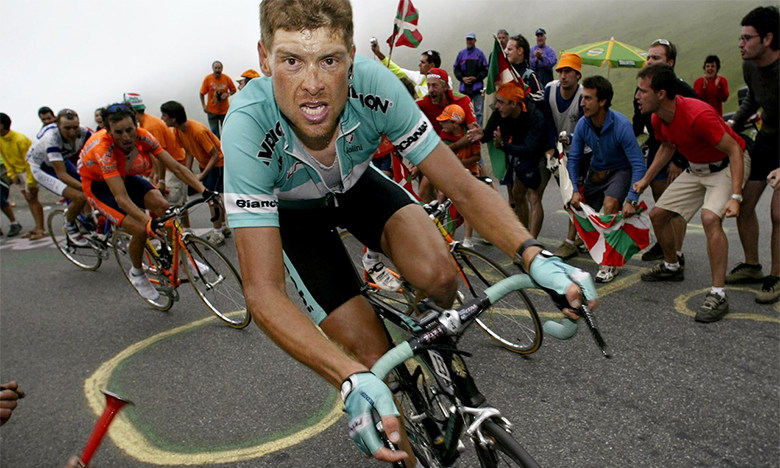The bikes whiz downhill faster than cars on a highway, with a pack of hundreds hungrily chasing a chance to make a breakaway. No one would deny that the Tour de France is a classic drama, but there was something downright Shakespearean about that hot July day in 2001.
Years earlier, before the fall of the Berlin Wall, unlikely athletes began escaping poverty in rural parts of the Soviet Union by getting involved with pro-cycling circuits. Many became legends, spurring a cycling craze that would outlive the Cold War’s end. But thesesame men, who overcame impoverished childhoods to gain fame in the East, would soon be outdone by the sport’s very Western expectations.
THE FALL OF THE BERLIN WALL CAUGHT UP EVEN THE GREATEST ATHLETIC HEROES IN AN ONGOING EUROPEAN IDENTITY CRISIS.
That steamy day, a Texan held the hearts of the world captive. Having miraculously survived testicular cancer and with two astonishing Tour de France wins alreadyunder his belt, Lance Armstrong was staking a major American claimto Europe’s most prestigious sport. He was climbing the Alpe d’Huez, the Tour’s most grueling test, and he was about to drop a bombshell. Pursuing Armstrong up the brutal 8.6-mile climb was his archrival, Jan Ullrich.
The former East German had won the Tour four years earlier and was out for blood — but he was also hurting. As the pair thundered around a turn on the back-splitting slope, Armstrong glanced back to meet the glare of Ullrich’s reflective sunglasses. “He took a look straight into the eyes, there, of Jan Ullrich and said, ‘Well, here I go! Are you coming or not?’ And the answer is — not!” spluttered Tour commentator Phil Liggett from the announcers’ box. Armstrong was charging up the road as if he’d been given new legs. What seemed like a cycling miracle was, as the world now knows, the product of performance-enhancing drugs. That day and that look mark the beginning of the end of Ullrich’s career. Armstrong would become the shamed poster boy for chemical boosts — but Ullrich and his colleagues would succumb as well and fall precipitously from grace.
Like Armstrong, it was a miracle that Ullrich was even competing. For eight decades, starting around the turn of the last century, winners of the Tour — considered the pinnacle of Western sporting achievement — were exclusively white and Western European. But in the 1980s and ’90s, international politics started upsetting this balance. Hungry young cyclists from Eastern Europe wanted their shot at glory on the other side of the Iron Curtain. Riders like Ullrich didn’t exactly fit the Western ideal of elite athletes. Many of them endured tough upbringings — champion sprinter Djamolidine Abdoujaparov, known as the “Tashkent Terror,” came from a family that had suffered deportation — while others went through rigorous Soviet sports training schools. But many of these Eastern Bloc riders were diamonds in the rough, and after the Cold War thawed, as cycling historian Herbie Sykes tells OZY, they proved far cheaper than French, Spanish and Italian riders for Western cycling teams to snap up.
Trouble was, these Eastern Bloc cyclists had a radically different approach forged by politics. Western cycling teams traditionally support an individual leader — aimed at claiming the maillot jaune, or yellow jersey, worn by the fastest man. “Eastern Bloc racing wasn’t as nuanced as commercial racing in the West,” Sykes explains. But, he adds, there was one major difference when it came to hitting the road: The Soviets “placed far more emphasis on the team.” They did as they were told, in other words, and were accustomed “to riding themselves into the ground,” Sykes says. At one point, organizers of the Peace Race, the Eastern Bloc’s largest and most celebrated cycling event, even considered banning the yellow jersey, Sykes says, “because individualism was anathema to the communist sports model.”
For Jan Ullrich, this training was both a blessing and a curse. In his early career, he unexpectedly ripped through the peloton, getting ahead of the pack; even though Ullrich was only 23, five-time Tour winner Miguel Indurain predicted he would win. Sure enough, Ullrich did, in 1997, sparking a German cycling frenzy. His tremendous legs and grim, awesome power earned him the nickname “Der Kaiser.” But the pressures of an increasingly off-the-rails sport took their toll on Ullrich. He spent years chasing Armstrong, and, in the mid-aughts, like so many onetime greats, he got caught up in the whirlwind of the doping controversy that changed cycling forever. Many other Eastern Bloc riders, like Ullrich’s Kazakh teammate Alexandre Vinokourov, met similar fates. Their training, however rigorous, was no match for the existing, entrenched drug culture lurking beneath the sport’s surface.
Cycling has been in crisis for years, and Armstrong’s downfall may have permanently damaged it. But within this disgrace lie complex politics that have a lot to teach us about Europe: The fall of the Berlin Wall caught up even the greatest athletic heroes in a European identity crisis that’s still working itself out today. To spot the shadow of the Wall, look no further than cycling — and how the East-West divide drove the sport farther downhill.

